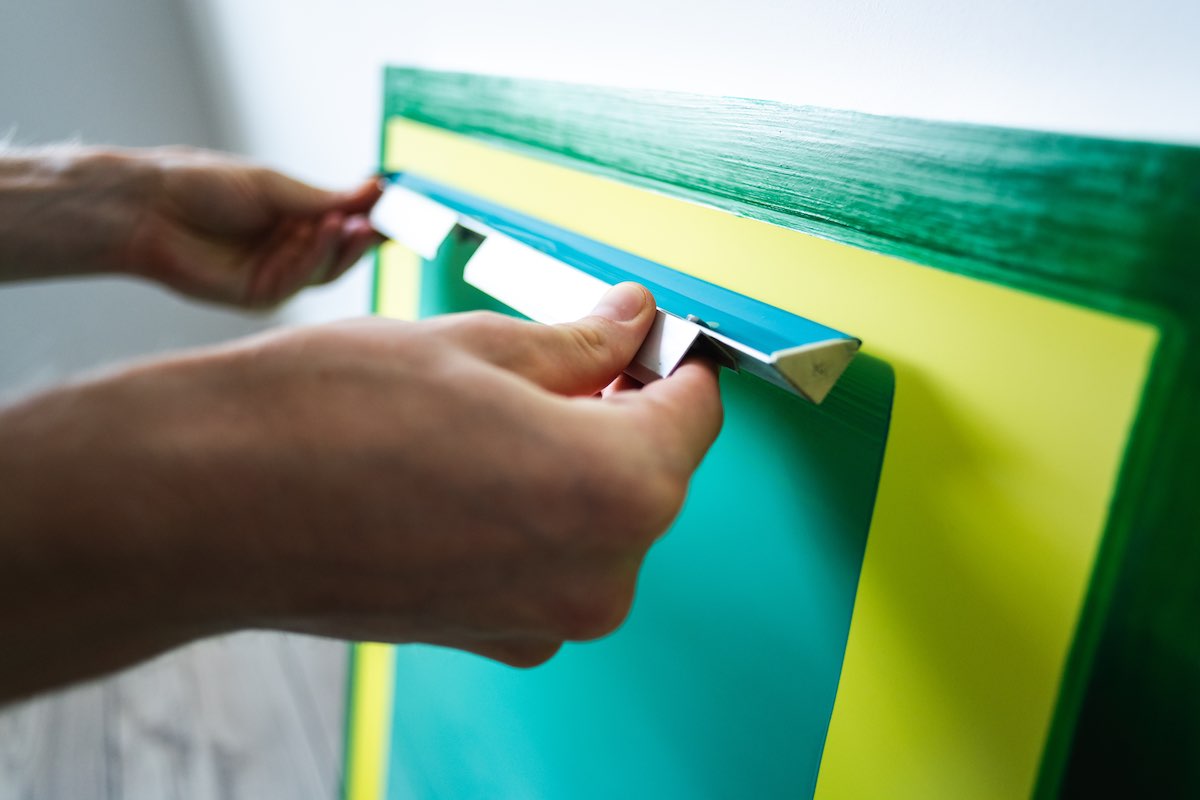When preparing a screenprinting frame, the emulsion can sometimes cause some issues. It’s no big deal – with some simple tricks you can still get a frame that’s ready to deliver great quality prints.
- In this article:
- The first step when cleaning the screen printing screen: remove the ink as follows
- Cleaning solvent-based inks from the screen printing screen
- Cleaning Plastisol inks from the screen printing screen
- How to clean the screen printing screen if you’re using water-based inks.
- Now the screen printing screen is clean: do you also want to get rid of the emulsion?
How many times have you emulsified a frame absolutely perfectly, let it dry and then, when you go to complete the exposure process by rinsing with water, all the emulsion washes away or, conversely, it doesn’t wash away at all?
Don’t worry, it happens. No matter the problem, there’s always a solution to ensure you don’t ruin the screen and still get great quality prints. Here are the most common issues.
Issue: the emulsion has gone bad
The pot or jar containing your emulsion usually displays the production date, not a use-by date: this is because there’s no legal requirement to provide a use-by date, and because there are many factors that can influence how long screen-printing emulsions last.
Unfortunately, it’s only when you come to expose the frame that you can understand if the emulsion has gone bad: the design’s details will be unclear or the entire layer of emulsion will come away when the screen is rinsed with water.
Solution:
The solution is to learn how to store your emulsions properly. Here’s what our experience has taught us:
– diazo emulsions: they last forever, until you add diazo to them. Once the diazo has been added, they’ll keep for 1 month at 20°C or for 3 months if kept in a fridge in a well-sealed container.
– diazo-free and ready-to-use emulsions: can be kept for one and a half years at 20°C or for three years in a fridge.
Issue: something is wrong with the exposure light
Are you trying to expose a diazo emulsion with white light?
Diazo emulsions won’t harden when exposed to white (non-UV) light, so they’ll completely wash away under water.
This should be apparent immediately after exposure: the emulsion on the frame will remain green, whereas if the exposure process has completed correctly, the emulsion should turn bluish.
Issue: formation of drops on the screen
This usually happens if too much emulsion is applied, it’s similar to what happens with paint (although emulsion is applied using a scoop coater and not a brush, of course).
- Solution:
- If you notice these drops while the emulsion is still wet, you can remove them, and make the layer more even, with the scoop coater. It’s a simple process and we recommend that you always check for drops before drying the frame.
- If the emulsion is already dry, the only option is to wash it with water – if it’s not been exposed yet, otherwise it’ll be necessary to use a stripper – allow it to dry and then apply the emulsion again.
Issue: micro-holes that allow the ink to pass through
If the layer of emulsion is too thin, micro-holes may appear on the emulsion that allow ink through during printing. The problem is that the layer of emulsion has been applied too thinly.
Solution:
- Always complete three passes when emulsifying the frame:
- once it’s exposed, check the screen against a light or bright surface and, if you notice any holes, use a small precision brush to fill them with fresh emulsion.
- allow the touch-ups to dry
- expose the frame so that the touch-ups harden. In the summer, you can also leave the frame in sunlight for 20 to 30 minutes and the emulsion will receive enough UV light to harden.
Issue: the water washes the emulsion away during the development process
- Usually these are the causes (and solutions):
- you used a diazo emulsion, but didn’t add any diazo
- the screen was exposed with insufficient light, or for an insufficient length of time. Wash the screen and start again: reapply the emulsion, expose and develop the screen again
- the type of light (white or UV) isn’t suitable for the emulsion – read the product datasheet carefully.
Issue: the emulsion comes away during printing
It can happen that the screen has been exposed and developed well, but the emulsion comes away during printing.
A possible reason for this can be that the light has hardened the emulsion sufficiently to resist the water during development, but not sufficiently to withstand the passing of the squeegee during printing.
Solution:
In this case, the screen should be left exposed to light again after development, even 30 minutes in the sun should suffice.
We don’t recommend using catalysts, because they make it impossible to reuse the screen. The “emulsification – exposure – wash” cycle should be repeatable countless times.
If, however, the problem is that the emulsion isn’t compatible with the ink you’re printing with, you must change the emulsion.
- Compatibility between emulsions and inks:
- emulsions for water-based inks: suitable for all ink types
- universal emulsions: suitable for all ink types
- emulsions for solvent-based inks: can resist solvent-based and plastisol inks, they dissolve when printing with water-based inks
One last tip: do one thing at a time
Emulsifying and developing frames requires experience and a lot of trial and error, so don’t be discouraged, you’ll get there, and don’t forget that the product manufacturers and retailers are available to help, so talk to them as well.
We suggest that when you’re carrying out your tests, just change one variable at a time: this is the only way to identify where the mistakes or issues lie.
Check out the videos on our YouTube channel
that explain how to use each type of emulsion

